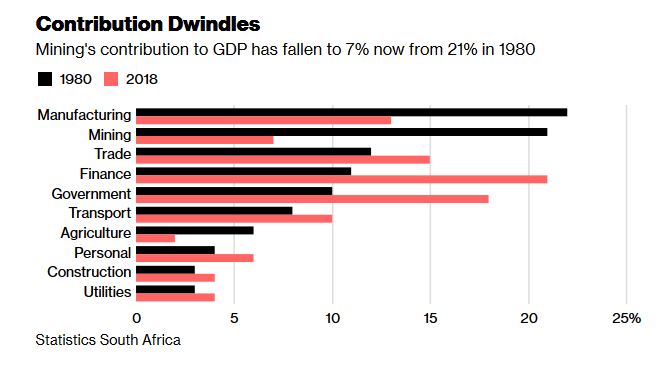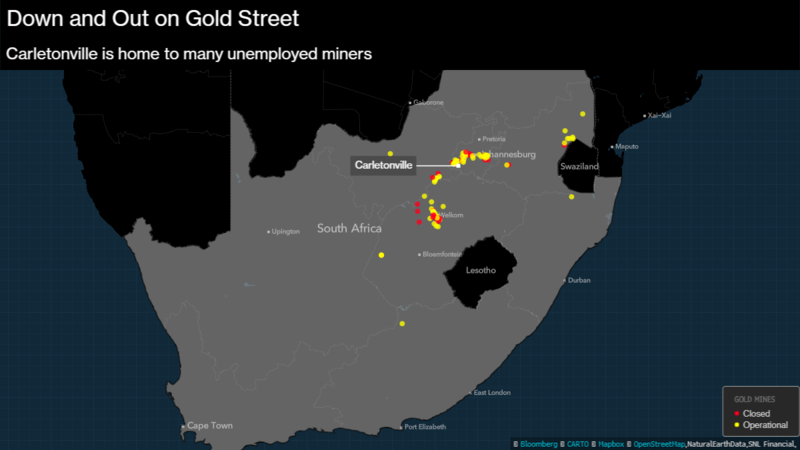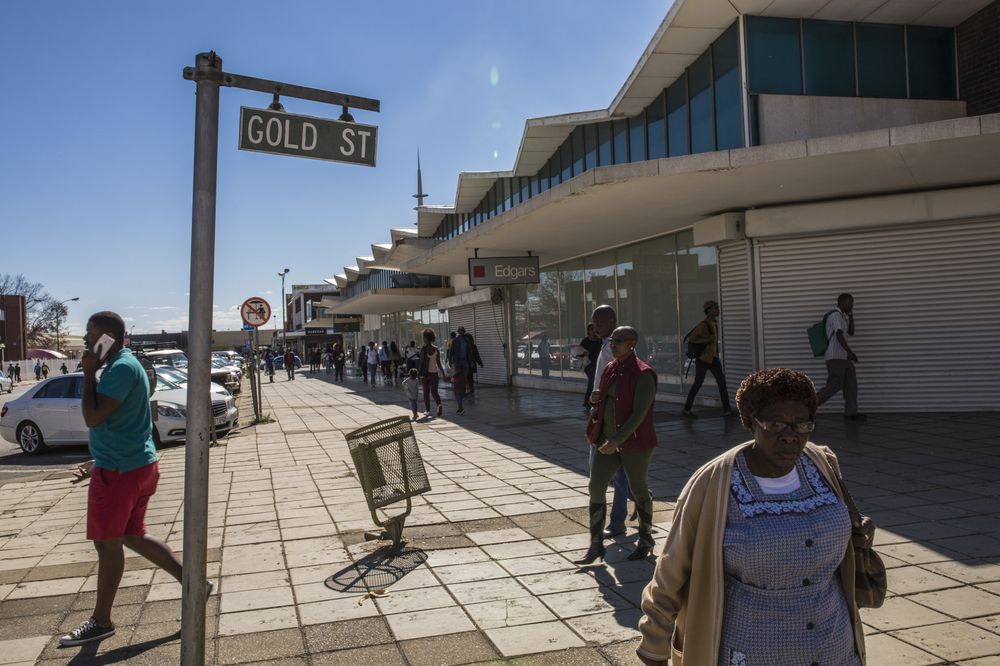
Pedestrians walk by closed-down retail outlets on Gold Street in Carletonville. Photographer: Guillem Sartorio/Bloomberg
The death rattle of the industry that once symbolized South Africa can be heard in the town of Carletonville—on Gold Street.
That’s where Paseka Selemela has been guarding cars since 2010, when the scaffolding business he worked for closed. Prior to that, he was an assistant at a now-shuttered mine owned by AngloGold Ashanti Ltd. Nor has he found work in other gold mines around the town, home to the world’s deepest shafts. Many of his friends and family members also have joined the legions of the retrenched, including 8,500 people in the area last year alone.
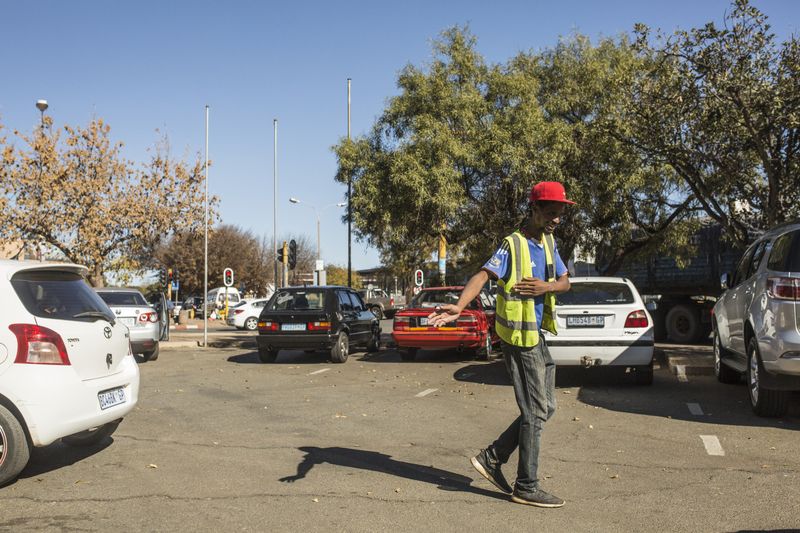
Photographer: Guillem Sartorio/Bloomberg
“These people can’t find jobs, just like me,” Selemela, 34, said under the winter sun, wearing a torn, dirty Chelsea soccer club shirt and jeans that hung loosely on his thin frame. “They try at the retailers, but there is nothing available there. They are employing fewer people because people are buying less. There’s no money.”
Additional cuts are to come across mines and towns in South Africa, once the world’s biggest producer of gold. A volatile currency, uncertainty about regulations and demand, labor union tensions, harder-to-access ore, high operating costs and falling prices mean about half of gold and platinum operations are loss-making.
More than 6 million people are unemployed and looking for work, taking the jobless rate to about 28 percent, a 15-year high. This excludes 2.5 million discouraged job seekers.
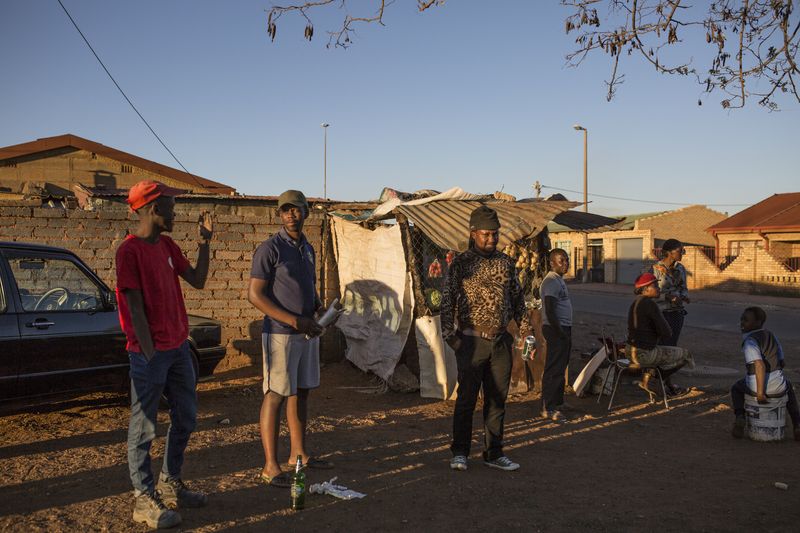
Photographer: Guillem Sartorio/Bloomberg
It’s a gargantuan task for newly elected President Cyril Ramaphosa, who came to office in February promising to revive the sluggish economy and clamp down on corruption. He’s spearheading a drive to attract $100 billion in new investments that could absorb unemployed youth as well as former mine and factory workers and to provide opportunities for young citizens.
He has his work cut out for him: The economy shrank the most in nine years in the first quarter, led by declines in agriculture, mining and manufacturing, Statistics South Africa said June 5. Gold production fell for the seventh straight month in April, the agency said on June 14. Foreigners are dumping South African bonds at the fastest pace since September 2008.
After gold was discovered near what was to become the economic hub of Johannesburg in 1886, the country became the biggest producer. The metal spawned some of the world’s largest mining companies, such as Anglo American Plc. It transformed South Africa from a farming economy into the continent’s most industrialized. It provided opportunities for unskilled black males, who were restricted from many jobs because of their race under white-minority-rule, known as apartheid.
In 1980, mining vied with manufacturing as the largest contributor to gross domestic product, with each at about 21 percent. Today, mines account for 7 percent of the economy. In 1987, the sector employed 763,000 people; that’s down more than 40 percent to 447,000 now. The government, retailers and banks are now the country’s biggest employers.
“A lot of the future of the industry is going to be based on constraining costs and a need to improve safety, but most particularly a focus on innovation and technology,” said Roger Baxter, chief executive officer of the Minerals Council of South Africa, which represents most producers. “It will continue to shrink until those initiatives start bearing good fruits.”
The newer platinum industry has its own problems. Producers are closing shafts and cutting thousands of jobs because a stronger rand and stagnating prices are squeezing profit margins. At the same time, reduced demand for diesel engines and the rise of electric cars threatens to erode the need for the metal, which is used in converters that control emissions in diesel-fueled vehicles. About 41 percent of platinum used last year was for this purpose, according to research from Johnson Matthey Plc, one of its top refiners.
“The industry is in crisis,” said Chris Griffith, CEO of Anglo American Platinum Ltd., the world’s largest producer. “It’s a chicken-and-egg situation. You need to invest yourself out of this situation by investing in growing demand.”
South Africa continues to be an important gold-mining jurisdiction worth investing in, said Bernard Swanepoel, a former CEO of Harmony Gold Mining Co. and board member of Impala Platinum Holdings Ltd., the world’s second-biggest producer.
“I really think it’s the last chapter, but the last chapter could be a good chapter,” he said. “Thirty more years of gold mining in South Africa could be a good chapter.”
And the country’s huge mineral endowment means chrome, iron ore and manganese—of which the nation has the world’s biggest known reserves—are becoming more important for exports, said Ross Harvey, a mining analyst at the South African Institute of International Affairs.
“Minerals such as iron ore have good prospects,” he said. “It’s an irreplaceable product for the steel industry. But as mines bring in new technology, that will continue to drive down jobs absorption.”
Draft rules published June 15 by Mineral Resources Minister Gwede Mantashe could hurt new operations. The Mining Charter says nearby communities and employees’ groups should get a 5 percent interest in either the asset or the company that owns it. The Minerals Commission and its members are opposed.
“The government could offer more tax incentives for the mining sector but the scope for this will be constrained by the need to reduce the budget deficit and stabilize public debt,” he said. “Beyond that, the government needs to improve its relationship with key mining-sector unions and persuade them to moderate their wage demands.”
South Africa has had success expanding its automotive industry, which now accounts for about 7 percent of GDP. Toyota Motor Corp., Ford Motor Co. and BMW AG all assemble vehicles locally. That can be put down to a state-incentive program that expires at the end of 2020, which both the carmakers and Trade and Industry Minister Rob Davies are eager to extend for another 15 years.
The state wants automakers to double the size of their combined workforce to about 225,000 to help to tackle the jobless rate, but the companies are reluctant to commit to specific targets. They view those as unrealistic given the global industry’s shift toward robotics and automation, said National Association of Automobile Manufacturers of South Africa Director Nico Vermeulen.
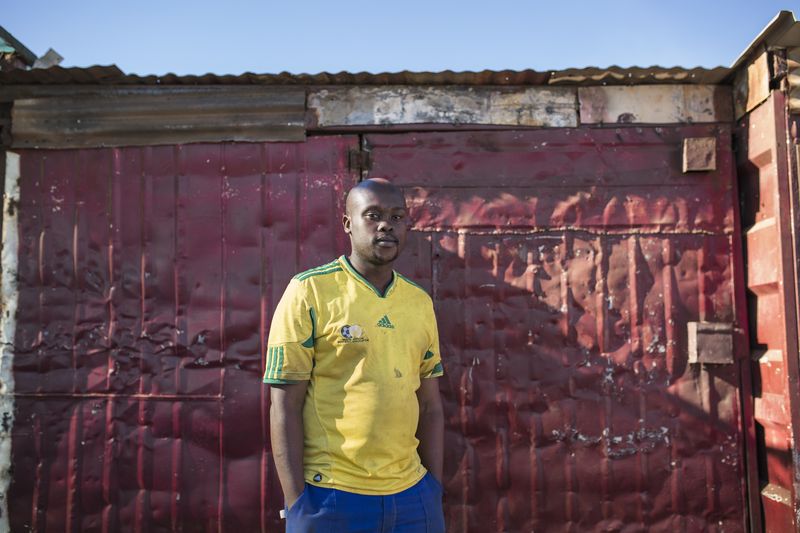
Photographer: Guillem Sartorio/Bloomberg
For Caldwell Nzimeni and his friends in Carletonville, working in a vehicle-assembly plant isn’t an option unless they migrate far from home and manage to acquire manufacturing skills they don’t have.
Nzimeni, 29, worked at Mponeng, the world’s deepest gold operation, for four years as an engineering assistant. He left in 2015 to complete his engineering studies but has been unsuccessfully applying for mine work for 18 months.
To make ends meet, he rents out shacks made from corrugated iron in the backyard of his home for 200 rand ($14) monthly and does plumbing and home-improvement jobs whenever he can find them. With the downturn in the town’s economy, his tenants are struggling to make their payments.
“I had hoped to return in a higher position with my qualification, but it hasn’t happened,” said Nzimeni, wearing blue work overalls and an old national soccer-team shirt sprayed with cement and grout after returning from an odd job installing a bathroom. “There are no jobs. Since the mines have closed, businesses are falling apart.”


